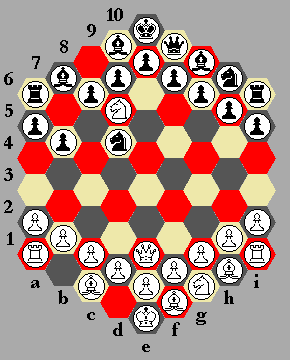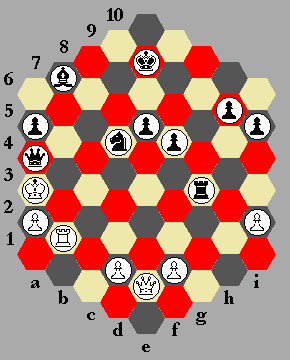 Game
#1 (Kindermatt)
Game
#1 (Kindermatt) Game
#1 (Kindermatt)
Game
#1 (Kindermatt)The shortest game ever.
1. Nb1-c4 Nc8-d6 2. Qd1-e3 b6-b5?? 3. Nc4-d7×.
The white Knight attacks the black King, Queen and Bishops' Rook at the same time. The King has nowhere to move, and Pawn e9 is pinned by the white Queen.
1. e2-e4
White threatens to attack both black Rooks by 2. Qd1-e2. Black could do the same (1. ... e9-e7 and then 2. ... Qf10-e9); here he chooses to cover one of the Rooks by a Pawn instead.
1. ... h9-h8 2. Qd1-e2 b6-b5 3. Bf2-e3
Preempting 3. ... Bg10:c2 and 4. ... Bc2:(R)a1.
3. ... Ra6-c6 4. d2-d4 a5-a4
Black now has the initiative, forcing White to think of defence.
1. Bf2-e3 e9-e7 2. h5-h6 a5-a4 3. Ri5-g5 f9-f7
Preempting 4. Bc1:g9.
4. Bc1-d3 b6-b5 5. i6-i7 Bg10:e9 6. b2-b3 a4:b3 7. c2:b3 Bb7-d5 8. Nb1-d4
White is loath to trade his Knight for a Bishop, as the latter man is the weaker one in this game, being restricted to only one-third of the board.
8. ... c7-c5 9. Nd4-c1 Ra6-a3
A more logical continuation would have been 9. ... c5:b3 10. Nc1:b3 Be9:b3 11. Qd1:b3, bringing about the exchange that White wanted to avoid.
10. b3-c5 Bd9-c7 11. Bd3-f4 Bc7:f4 12. Rg5:f4 Be9:c5 13. Nc1-d4 Bc5-b3!
A move which wins a quality. A continuation which would have led to an exchange is 13. ... Bc5:a1 14. Nd4:a3 Ba1:e3 15. Qd1-c1 b5:a3 16. Qc1:c8+ Qf10-d9 17. Qc8:d9+ Ke10:d9 18. Rf4:e3, with White in a better position.
14. Qd1-c1 Ra3-c5 15. Ra1-c3 Bd5:c3 16. d2:c3 Bb3:d4 17. Rf4:d4 Rc5-i5
A dubious move. Black's Rook has become inactive for some time. White is preparing to attack.
18. Bh4-i6+ Ke10-d9
18. ... h9-h7 wouldn't have done because of 19. i7:h8 e.p.+.
19. Ke1-f2 i9-i8 20. Qc1-d3 i8:h6 21. g4:h6 Ri5:g3+??
The thing to do would have been 21. ... Ri5-c5.
22. Kf2:g3 Ri10:i7 23. Bi6-h4 Ri7:h6 24. Be3-g4 Rh6-g6 25. Qd3-h5 Nh10-i8 26. Qh5-c5 Qf10-e9 27. Rd4-d7 Ni8-f6
See diagram.
28. Bh4:f6
28. Qc5-c7+ leads to lingering struggle. After 28. Kd9-e10 White has to think of defending his position by 29. Bh4-g5. The move 29. Bh4:f6 will no longer do because of 29. ... Qe9-i5+ 30. Bg6-h4 Qi5:g4× or 30. Kg3-f4 Qi5:g4×.
28. ... Rg6:f6 29. Qc5-c7+ Kd9-e10 30. Rd7-e8
Black loses his Queen and resigns. The same would have happened after 29. ... Kd9-f10 30. Rd7:d8.
1. e2-e4 e9-e7 2. Bc1-e2 Qf10-e9 3. Be2:i10 Qe9:i5
An erroneous start for White, letting Black take the initiative.
4. Nb1-e3 Bd9:h5 5. Qd1-e2 b6-b5
Threatening to play 6. ... Bg10:c2.
6. Q-0-0-0 Nh10-g7
An active proposal of an exchange of the black Bishop on h5 for the more valuable white Knight on g3.
7. Ng3-h6
White can't afford 7. Bi10:g9 because of 7. ... Bh5-f4, which would lead to the loss of the white Knight on g3.
7. ... Bh5-f7 8. Nh6:f7
A forced exchange. By attacking the Rook Black was threatening to close up White's white-field Bishop on i10 by 8. ... h9-h8.
8. ... g9:f7 9. Bi10:c7 Ra6-c6 10. Bc7-f4 d8-d5 11. e4:d5 Ng7:d5
Black is preparing to break up the white King's Pawn covering. The Pawn on c2 is attacked thrice. White should play 12. Ne3:d5.
12. Bh4-f6??
A spectacular move, but an erroneous one none the less, leading as it does to the loss of an officer. Black can't respond by 12. ... e7:f6, as White will capture his Queen after 13. Ne3-g6+, nor by 12. ... Nd5:e3+, because of 13. Bf2:e3 Rc6:f6 14. g4-g5, attacking the black Queen and Rook at the same time.
12. ... Nd5:f4 13. Qe2:f4 Qi5:f2
Or 13. ... e7:f6, capturing a Bishop in either case.
 Black
now has a significant material advantage. He terminates the game by a direct
attack on the white King.
Black
now has a significant material advantage. He terminates the game by a direct
attack on the white King.
14. Bf6-h4 Bg10:c2!
The black Bishop is safe: 15. Rc1:c2 Qf2-e1+ 16. Rc2-c1 Qe1:c1×.
15. Ne3-c4 b5:c4 16. Rc1:c2 Qf2:h4 17. Qf4-i10+ Ke10-e9 18. Qi10-e2 c4:b2 19. Rc2:b2 Rc6-g6+ 20. Kb1-a1 Qh4:g4+ 21. Ka1-b3 Nc8-d6+ 22. Kb3-a3 Qg4-a4×
See diagram. The response to 22. Kb3-c5 would also have been 22. ... Qg4-a4×.